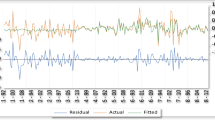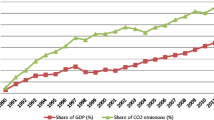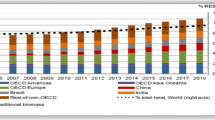Abstract
This study aims to examine the impact of renewable and non-renewable energy consumption on the agriculture, industry, services, and overall economic activities (GDP) across a panel of G20 nations. The study makes use of annual data from 1980 to 2012 on 17 countries of the G20. To achieve the study objectives, we apply several robust panel econometric models which account for cross-sectional dependence and heterogeneity in the analysis. The empirical findings confirm the significant long-run equilibrium relationship among the variables. The long-run elasticities indicate that both renewable and non-renewable energy consumptions have significant positive effect on the economic activities across the sectors and also on the overall economic output. These results also imply that the impact is more from renewable energy on economic activities than that of non-renewable energy. Given that, our results offer significant policy implications. We suggest that the policy makers should aim to initiate effective policies to turn domestic and foreign investments into renewable energy projects. This eventually ensures low carbon emissions and sustainable economic development across the G20 nations.
Similar content being viewed by others
Notes
Authors have considered industrial and service sectors as the modern sectors.
We excluded Russia and Saudi Arabia from the sample due to unavailability of the data.
A number of recent studies (e.g., Alam et al. 2017; Alam and Paramati 2016; Paramati et al. 2017a) have applied the panel unit root tests which account for cross-sectional dependence in the analysis, while some other studies (e.g., Alam and Paramati 2015) did not account for cross-sectional dependence while estimating panel unit root tests.
Cerrato et al. (2013) provide detailed discussion on linear and non-linear panel unit root tests.
References
Abbas F, Choudhury N (2013) Electricity consumption-economic growth nexus: an aggregated and disaggregated causality analysis in India and Pakistan. J Policy Model 35(4):538–553
Alam MS, Paramati SR (2015) Do oil consumption and economic growth intensify environmental degradation? Evidence from developing economies. Appl Econ 47(48):5186–5203
Alam MS, Paramati SR (2016) The impact of tourism on income inequality in developing economies: does Kuznets curve hypothesis exist? Ann Tour Res 61:111–126
Alam MS, Paramati SR (2017) The dynamic role of tourism investment on tourism development and CO2 emissions. Ann Tour Res 66(C):213–215
Alam, M. S., Paramati, S. R., Shahbaz, M., & Bhattacharya, M. (2015). Dynamics of natural gas consumption, output and trade: empirical evidence from the emerging economies. No. 21-15. Monash Economics Working Papers, Monash University, Department of Economics
Alam MS, Paramati SR, Shahbaz M, Bhattacharya M (2017) Natural gas, trade and sustainable growth: empirical evidence from the top gas consumers of the developing world. Appl Econ 49(7):635–649
Al-mulali U, Fereidouni HG, Lee JY, Sab CNBC (2013) Examining the bi-directional long run relationship between renewable energy consumption and GDP growth. Renew Sust Energ Rev 22:209–222
Alper A, Oguz O (2016) The role of renewable energy consumption in economic growth: evidence from asymmetric causality. Renew Sust Energ Rev 60:953–959
Apergis N, Payne JE (2010) Renewable energy consumption and economic growth: evidence from a panel of OECD countries. Energy Policy 38(1):656–660
Apergis N, Payne JE (2011) The renewable energy consumption–growth nexus in Central America. Appl Energy 88(1):343–347
Apergis N, Payne JE (2012) Renewable and non-renewable energy consumption-growth nexus: evidence from a panel error correction model. Energy Econ 34(3):733–738
Ben Aïssa MS, Ben Jebli M, Ben Youssef S (2014) Output, renewable energy consumption and trade in Africa. Energy Policy 66:11–18
Ben Jebli M, Ben Youssef S (2015) Output, renewable and non-renewable energy consumption and international trade: evidence from a panel of 69 countries. Renew Energy 83:799–808
Bhattacharya M, Awaworyi Churchill S, Paramati SR (2017) The dynamic impact of renewable energy and institutions on economic output and CO2 emissions across regions. Renewable Energy 111:157–167
Bhattacharya M, Paramati SR, Ozturk I, Bhattacharya S (2016) The effect of renewable energy consumption on economic growth: evidence from top 38 countries. Appl Energy 162:733–741
Bloch H, Rafiq S, Salim R (2015) Economic growth with coal, oil and renewable energy consumption in China: prospects for fuel substitution. Econ Model 44:104–115
Bowden N, Payne JE (2009) The causal relationship between U.S. energy consumption and real output: a disaggregated analysis. J Policy Model 31(2):180–188
Bowden N, Payne JE (2010) Sectoral analysis of the causal relationship between renewable and non-renewable energy consumption and real output in the US. Energy Sources, Part B: Economics, Planning, and Policy 5(4):400–408
Cerrato M, De Peretti C, Stewart C (2013) Is the consumption–income ratio stationary? Evidence from linear and non-linear panel unit root tests for OECD and non-OECD countries. Manch Sch 81(1):102–120
Costantini V, Martini C (2010) The causality between energy consumption and economic growth: a multi-sectoral analysis using non-stationary cointegrated panel data. Energy Econ 32(3):591–603
Dumitrescu E-I, Hurlin C (2012) Testing for Granger non-causality in heterogeneous panels. Econ Model 29(4):1450–1460
Gozgor G (2016) Are shocks to renewable energy consumption permanent or transitory? An empirical investigation for Brazil, China, and India. Renew Sust Energ Rev 66:913–919
Gozgor G, Demir E (2017) Evaluating the efficiency of nuclear energy policies: an empirical examination for 26 countries. Environ Sci Pollut Res 24(22):18596–18604
IEA, 2014a. World energy statistics and balances (2014), UN Energy Statistics, Paris
IEA. 2014b. International energy administration, World Energy Statistics and Balances, UN Energy Statistics
IEO, 2016. International energy outlook, U.S. International Energy Administration. Washington, DC
Im KS, Lee J, Tieslau M (2005) Panel LM unit root tests with level shifts. Oxf Bull Econ Stat 67(1):393–419
Im KS, Pesaran MH, Shin Y (2003) Testing for unit roots in heterogeneous panels. J Econ 115(1):53–74
Inglesi-Lotz R (2016) The impact of renewable energy consumption to economic growth: a panel data application. Energy Econ 53:58–63
IRENA. (2016a), IRENA resource renewable energy statistics. IRENA Data Stat. IRENA, Abu Dhabi
IRENA. (2016b), G20 toolkit for renewable energy deployment: country options for sustainable growth based on REmap. International Renewable Energy Agency (IRENA)
Kutan AM, Paramati SR, Ummalla M, Zakari A (2017) Financing renewable energy projects in major emerging market economies: evidence in the perspective of sustainable economic development. Emerging Markets Finance and Trade available online
Lau CKM, Suvankulov F, Su Y, Chau F (2012) Some cautions on the use of nonlinear panel unit root tests: evidence from a modified series-specific non-linear panel unit-root test. Econ Model 29(3):810–816
Marques AC, Fuinhas JA, Menegaki AN (2016) Renewable vs non-renewable electricity and the industrial production nexus: evidence from an ARDL bounds test approach for Greece. Renewable Energy 96(Part A):645–655
Menegaki AN (2011) Growth and renewable energy in Europe: a random effect model with evidence for neutrality hypothesis. Energy Econ 33(2):257–263
Newey WK, West KD (1994) Automatic lag selection in covariance matrix estimation. Rev Econ Stud 61(4):631–653
Ocal O, Aslan A (2013) Renewable energy consumption–economic growth nexus in Turkey. Renew Sust Energ Rev 28:494–499
Ohler A, Fetters I (2014) The causal relationship between renewable electricity generation and GDP growth: a study of energy sources. Energy Econ 43:125–139
Pao H-T, Fu H-C (2013) Renewable energy, non-renewable energy and economic growth in Brazil. Renew Sust Energ Rev 25:381–392
Paramati SR, Alam MS, Chen CF (2017a) The effects of tourism on economic growth and CO2 emissions: a comparison between developed and developing economies. J Travel Res 56(6):712–724
Paramati SR, Apergis N, Ummalla M (2017b) Financing clean energy projects through domestic and foreign capital: the role of political cooperation among the EU, the G20 and OECD countries. Energy Econ 61:62–71
Paramati SR, Mo D, Gupta R (2017c) The effects of stock market growth and renewable energy use on CO2 emissions: evidence from G20 countries. Energy Econ 66:360–371
Paramati SR, Shahbaz M, Alam MS (2017d) Does tourism degrade environmental quality? A comparative study of Eastern and Western European Union. Transp Res Part D: Transp Environ 50:1–13
Paramati SR, Sinha A, Dogan E (2017e) The significance of renewable energy use for economic output and environmental protection: evidence from the next 11 developing economies. Environ Sci Pollut Res 24(15):13546–13560
Paramati SR, Ummalla M, Apergis N (2016) The effect of foreign direct investment and stock market growth on clean energy use across a panel of emerging market economies. Energy Econ 56:29–41
Payne JE (2009) On the dynamics of energy consumption and output in the US. Appl Energy 86(4):575–577
Pesaran, M. H. (2004). General diagnostic tests for cross-section dependence in panels working paper: University of Cambridge
Pesaran MH (2006) Estimation and inference in large heterogeneous panels with a multifactor error structure. Econometrica 74(4):967–1012
Pesaran MH (2007) A simple panel unit root test in the presence of cross-section dependence. J Appl Econ 22(2):265–312
Phillips PCB, Sul D (2003) Dynamic panel estimation and homogeneity testing under cross section dependence. Econometrics Journal 6(1):217–259
Sadorsky P (2009) Renewable energy consumption and income in emerging economies. Energy Policy 37(10):4021–4028
Salim RA, Hassan K, Shafiei S (2014) Renewable and non-renewable energy consumption and economic activities: further evidence from OECD countries. Energy Econ 44:350–360
Shahbaz M, Islam F, Butt MS (2016) Finance–growth–energy nexus and the role of agriculture and modern sectors: evidence from ARDL bounds test approach to cointegration in Pakistan. Glob Bus Rev 17(5):1037–1059
Smith LV, Leybourne S, Kim T-H, Newbold P (2004) More powerful panel data unit root tests with an application to mean reversion in real exchange rates. J Appl Econ 19(2):147–170
Tang CF, Shahbaz M (2013) Sectoral analysis of the causal relationship between electricity consumption and real output in Pakistan. Energy Policy 60:885–891
Tugcu CT, Ozturk I, Aslan A (2012) Renewable and non-renewable energy consumption and economic growth relationship revisited: evidence from G7 countries. Energy Econ 34(6):1942–1950
Westerlund J (2008) Panel cointegration tests of the Fisher effect. J Appl Econ 23(2):193–233
Zachariadis T (2007) Exploring the relationship between energy use and economic growth with bivariate models: new evidence from G-7 countries. Energy Econ 29(6):1233–1253
Author information
Authors and Affiliations
Corresponding author
Additional information
Responsible editor: Philippe Garrigues
Rights and permissions
About this article
Cite this article
Paramati, S.R., Apergis, N. & Ummalla, M. Dynamics of renewable energy consumption and economic activities across the agriculture, industry, and service sectors: evidence in the perspective of sustainable development. Environ Sci Pollut Res 25, 1375–1387 (2018). https://doi.org/10.1007/s11356-017-0552-7
Received:
Accepted:
Published:
Issue Date:
DOI: https://doi.org/10.1007/s11356-017-0552-7
Keywords
- Renewable energy consumption
- Sectoral economic activities
- Sustainable economic growth
- Cross-sectional dependence
- G20




